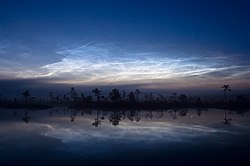ISS 17 - Noctilucent clouds over Asia
Autor:
NASA
Shortlink:
Zdroj:
Formát:
3072 x 2040 Pixel (266890 Bytes)
Popis:
Noctilucent clouds photographed by the crew of the ISS.
- Polar Mesospheric Clouds (also known as noctilucent clouds) are transient, upper atmospheric phenomena observed usually in the summer months at high latitudes (greater than 50 degrees) of both the Northern and Southern Hemispheres. They are bright and cloudlike in appearance while in deep twilight. They are illuminated by sunlight when the lower layers of the atmosphere are in the darkness of the Earth's shadow. This image was acquired at an altitude of just over 320 km (200 miles) in the pre-dawn hours of 22 July 2008 as the International Space Station was passing over western Mongolia in central Asia. The dark horizon of the Earth appears below with some layers of the lower atmosphere already illuminated. The higher, bluish-colored clouds look much like wispy cirrus clouds which can be found in the troposphere as high as 18 km (60,000 feet).
- However noctilucent clouds, as seen here, are observed in the mesosphere at altitudes of 75 to 85 km (250,000 to 280,000 feet). Astronaut observations of Polar Mesospheric Clouds (PMC) over northern Asia in June and July are not uncommon. The Expedition 17 crew of the International Space Station acquired this image, and more, in support of research for the International Polar Year. Some researchers link increased observations of PMC to changes in global climate; PMC have been the subject of extensive observation and research from space by the Swedish satellite Odin launched in 2001 and more recently by NASA's Aeronomy of Ice in the Mesosphere (AIM) satellite system beginning in 2007.
Licence:
Public domain
Credit:
Relevantní obrázky
Relevantní články
Noční svítící oblakNoční svítící oblak, známý také jako polární mezosférický oblak nebo noctilucent, je úkaz v horní části atmosféry viditelný při soumraku či rozbřesku. Je tvořen krystalky zmrzlé vody. Jméno oblaku pochází z latinského nox = „noc“ a lucere = „svítit“. Většinou jej lze pozorovat v letních měsících v zeměpisné šířce mezi 50 a 70° severně či jižně od rovníku. .. pokračovat ve čtení


